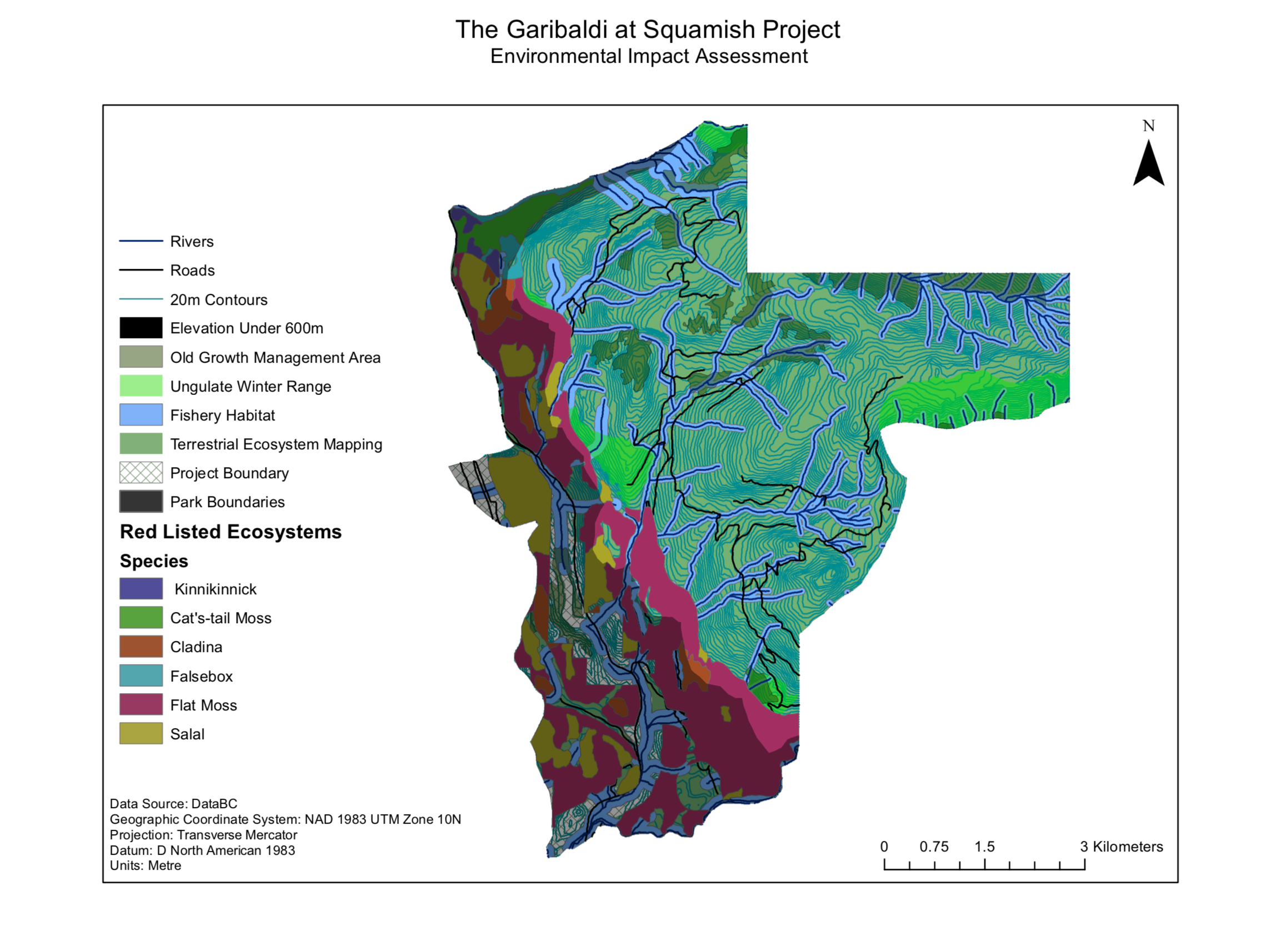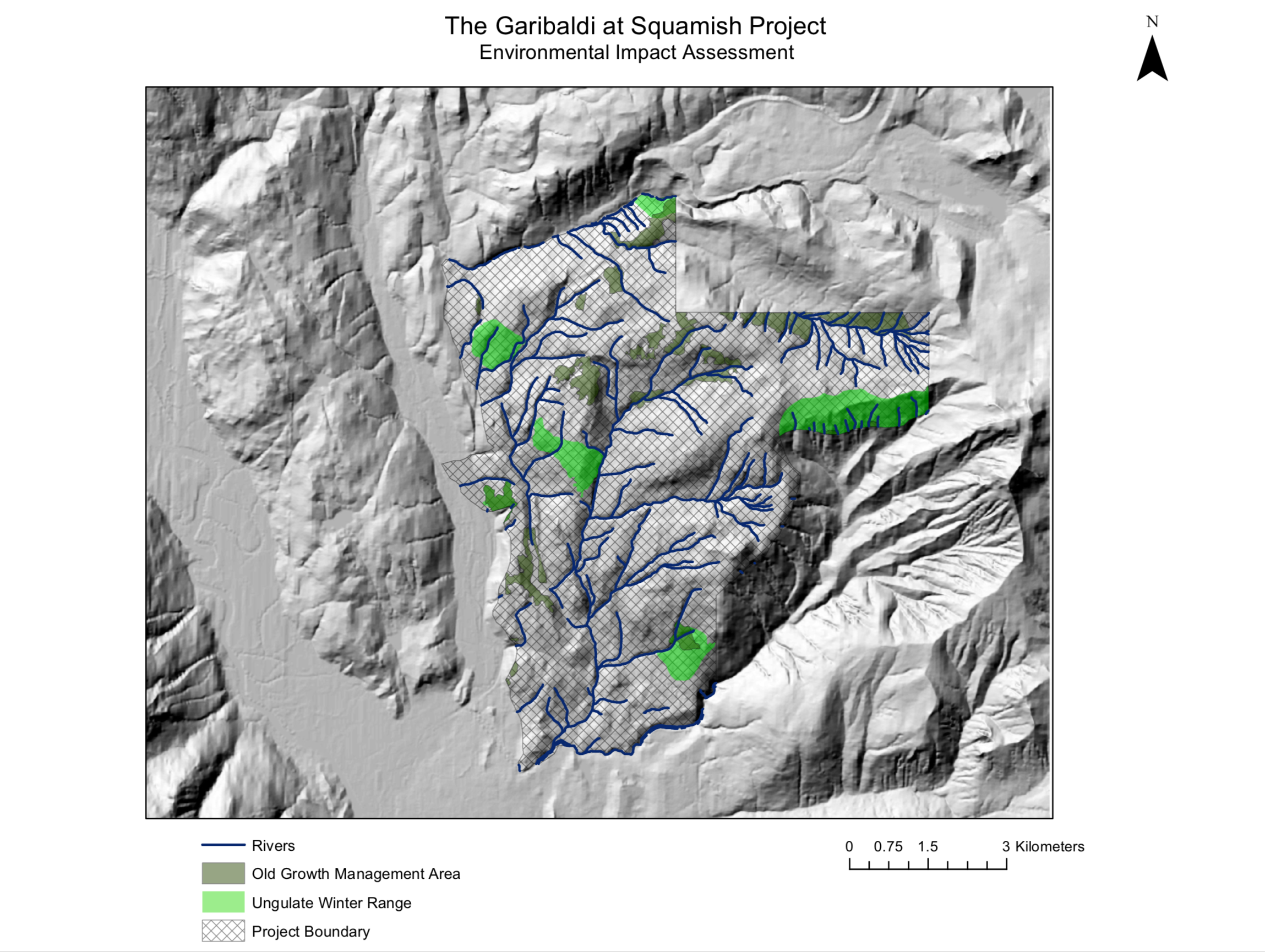The Garibaldi at Squamish Project
The Garibaldi is a proposed year-round mountain resort on Brohm Ridge. It will include 124 ski trails and 21 ski lifts as well al resort accommodation and commercial developments. Northland Properties and Aquilini Investment Group of Vancouver first submitted an application for the project under the Environmental Assessment Act in 1997. In 2010, the BC Environmental Assessment Office released a report stating that the proposed project lacked important information on the potential effects on vegetation, fish and wildlife habitat and recommended measures to reduce significant environmental, social, economic, heritage and health effects. Once the proponent filed an application that they claimed addressed these issues in 2015, the Resort Municipality of Whistler replied with a 14-page letter that opposed the proposed project. As a natural resource planner for the British Columbia Snowmobile Federation (BCSF), I aim to examine the Environment Impact Assessment’s recommendation as well as Whistler’s criticisms to determine if there is sufficient evidence to oppose the project.
The map below displays The Garibaldi project boundary as well as all the aspect that I have assessed in my environmental assessment. It specifies the ecosystem species that are considered red-listed or endangered as well as displays the ungulate, fisheries, and the old growth areas that will be impacted if this project is approved.

Also presented below is a map that displays a more third-dimensional look at The Garibaldi and the rivers that run within the project boundary as well as the ungulate and old growth tree areas that would be significantly impacted by this project.

Findings for the Areas of Environmental Concern
My job for this proposed project was to examine and analyze the data. The data first had to be obtained as the current project proposal lacked sufficient information on the possible effects the Garibaldi would have on wildlife, vegetation, fisheries and their surrounding habitats. Once I obtained the data, we had to filter the data of interest to the project boundary so we could get specific calculations and effects on the impacted rivers, old growth forests, ungulate habitats and the fisheries. We found the total area of the project boundary and were able to use that total to isolate and compare the areas of impacted ecosystem factors to find a total percentage of the land that is being affected by the project. Once we found those calculations of the specific areas that were being impacted, we were able to specifically present the endangered species that will be destroyed and the riparian areas that will be greatly destroyed. During my analysis, I found that 53.6 of the total land area within the proposed project boundary will be impacted if the project is approved. The table below are my calculations of the environmental areas of concern if the Garibaldi project was approved.

Another finding is that 31.8% of the total area within the proposed project boundary is on the lower 600 metres of the vertical meaning that 31.8% of the total land area is unsuitable for skiing as the climatological conditions are not reliable to have constant ski quality snow due to climate change.
Future Recommendations
Looking quantitatively at the results from the analysis, more than half the land area will be impacted or destroyed if the Garibaldi project went through so I recommend to the Northland Properties and Aquilini Investment Group of Vancouver that they need to be vigilant when deciding where to place the ski-resort facilities or the trails to lessen as much of the impact on the red-listed ecosystems or delicate biodiversity zones.
The two greatest environmental concerns to the development of the Garibaldi include the riparian zones and fish habitats and the red-listed ecosystems. The mitigation efforts on these concerns are slim as once they are destroyed, it is rare that these habitats will return back to what the originally were. If construction were to occur, the proponents need to ensure that the least amount of disruption or pollution such as runoff, noise pollution and gas emissions will occur. Fish populations have very specific environmental needs to thrive and anything from water temperatures, water turbidity and a change in social content can majorly affect their populations which will further cause an imbalance in fish populations to those who rely on fish as their primary food source such as the First Nations.
I recommend that both proponents need to review the extent that their project will have on these ecosystem concerns and do not just look at the project economically as well as environmentally. Further environmental impact assessments can be concluded to see if there are any possible ways that the wetlands or red-listed ecosystems can be properly mitigated.
Personally, I do not think that this ski-hill resort project should be approved. There are many other fantastic ski hills to go to such as Whistler Blackcomb or the Sunshine Resort in Banff if you are able to make a road trip. Too much of the environment will be degraded if this project were to go through and these environments do not have the ability or resilience to withstand the construction conditions.
Here are a few of the main skills that I have obtained while working with ArcGIS for this lab and in this course:
- Obtain BC Government data using the online DataBC source to perform an environmental analysis on the proposed Garibaldi project
- Produced an environmental assessment map of The Garibaldi at Squamish project which allowed me to display the factors that would be impacted with the development of this project
- Produce a 3D hill shade map of the environmental assessment that highlighted the topography and slope of the project area
- Complete a memo for the proponents of the Garibaldi including the objectives of the project, the findings and recommendations.